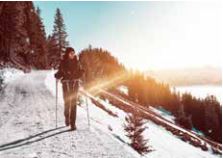Even though Trail Ridge Road in Rocky Mountain National Park will be closed for the winter, there are many winter activities at the lower elevations. This is a magical time to visit the park, a time when there are fewer crowds and it’s easy to enjoy both solitude and snow on a winter wilderness adventure.

Skiing at RMNP
However, there are unique challenges associated with the winter and spring seasons to be prepared for: snowpacked and icy roads, temperatures that frequently drop below freezing, as well as seasonal road closures. Extra planning is key to a successful winter adventure in Rocky Mountain National Park.
With elevations ranging from 7,800 feet to over 14,000 feet, winter conditions can greatly vary in the Rocky Mountains. The winter season, especially at locations above 8,000 feet, can stretch from late September or early October to late May or early June.
While March and April may signal the arrival of warm, sunny days in many parts of the U.S., that does not hold true in Rocky Mountain National Park. Historically, March and April are among the snowiest months in the State of Colorado, especially at high elevations. If you are planning for a spring break trip, or even a trip in early to mid-May, pack your snowboots, and warm clothes! You need to be ready for winter conditions.
Did you know that many of the park’s winter trails, including destinations in the Bear Lake and Hidden Valley areas, are located within significant avalanche terrain? Avalanches can be triggered by snowshoers, winter hikers, backcountry skiers, and even wildlife.
And last, the winter season creates some unique wildlife viewing opportunities. To learn more about how to safely view wildlife, please visit their Wildlife Viewing page at www.nps.gov/romo/planyourvisit/wildlife_view.htm.
Rocky Mountain National Park has six live webcams located at Alpine Visitor Center, Kawuneeche Valley, Glacier Basin Campground, Longs Peak, Fall River & Beaver Meadows entrances. Visit their website at www.nps.gov/romo/learn/photosmultimedia/webcams.htm.
